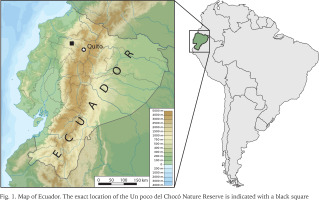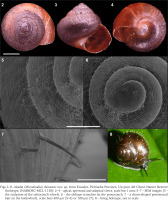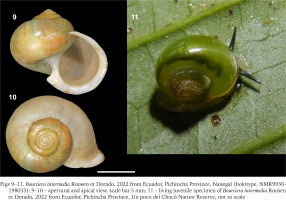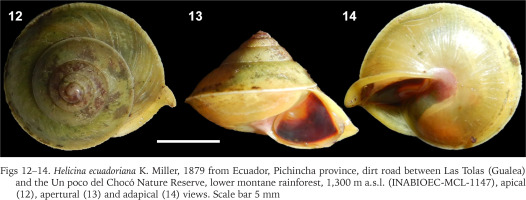INTRODUCTION
The non-marine mollusks of mainland Ecuador are highly diverse, but poorly known (Correoso 2008). Breure et al. (2022) report 331 species, of which 168 have not been reported recently and 179 are considered to be endemic to Ecuador. As more than 70% of the 80 taxa found in the Los Cedros reserve only could not be assigned to any of the described species (Ramirez Perez & Hausdorf 2022), the true non-marine molluscan biodiversity of Ecuador is probably much higher.
In 2019, an extensive study was conducted in the Un poco del Chocó Nature Reserve (hereafter referred to as UPDC), a relatively small rainforest fragment in the North-Western Pichincha province, Ecuador. The purpose of this study was to assess the terrestrial gastropod biodiversity of this reserve and collect the first data on their ecology and resilience to human activity. However, many of the species recovered were either new to science, forgotten in subsequent publications or wrongly considered to be a synonym of a different taxon.
In this paper, the taxonomy of the Helicinidae that occur in UPDC will be clarified and a new species will be described. Other taxa will be treated in subsequent papers, all to facilitate the publication of ecological data and to enable the protection of these species.
MATERIAL AND METHODS
AREA DESCRIPTION
The Un poco del Chocó Nature Reserve (UPDC) is located in the Pichincha province in Northwest Ecuador near Las Tolas (Gualea) (Fig. 1). This area is part of the Chocó ecoregion. The terrain is approximately 15 hectares and consists of both primary and secondary rainforest. The altitude in the reserve varies from 950 to 1,200 m a.s.l.
Fig. 1
Map of Ecuador. The exact location of the Un poco del Chocó Nature Reserve is indicated with a black square

All specimens from the UPDC were collected in 2019 by the author as part of a more extensive ecological study (Roosen, in preparation). The collection methods used along with the biodiversity, dispersion and ecological data will be described in the forthcoming paper. Most helicinid specimens in UPDC were recovered accidentally, outside of standard methodology.
DESCRIPTION OF THE SPECIES
Specimens were identified following publications by Wagner (1911), Breure et al. (2022) and Roosen & Dorado (2022) or papers cited herein. Richling (2004), Hausdorf (2006) and Guevara (2008) were also consulted in an attempt to identify Alcadia (Microalcadia) chocoensis sp. nov. as a known species and to gain some insights on the subgenus Microalcadia in general.
Measurements were taken to the nearest 0.1 mm using Vernier calipers. Shell height (H) was measured from the apex to the lowest part of the inner lip of the aperture. The shell width (W) was measured at the widest section perpendicular to the coiling axis. Height of the aperture (HA) was measured from the lowest to the highest extension of the peristome. All measurements are in mm. Whorls were counted to the nearest 1/4 whorl following Gittenberger et al. (2004). The research permit issued for this study prohibits the use of DNA sequencing. Therefore molecular data will not be included in the species description.
Type material of the species described in this paper is deposited in the collection of the Instituto Nacional de Biodiversidad (INABIO), Quito, Ecuador. Other museum collections used: Natural History Museum Rotterdam, Rotterdam, the Netherlands (NMR) and the Zoological Museum Hamburg, Hamburg, Germany (ZMH). Other abbreviations: Coll. – Collection, obs. – observation, TL – type locality, SEM – Scanning Electron Microscope, m a.s.l. – meters above sea level.
SYSTEMATIC PART
Family: Helicinidae Férussac, 1822
Genus: Alcadia Gray, 1840
Subgenus: Alcadia (Microalcadia) Richling, 2004
Alcadia (Microalcadia) chocoensis sp. nov.
Figs 2–8
Alcadia (Microalcadia) chocoensis nov. sp. from Ecuador, Pichincha Province, Un poco del Chocó Nature Reserve (holotype, INABIOEC-MCL-1138): 2–4 – apical, apertural and adapical views, scale bar 1 mm; 5–7 – SEM images (5 – the sculpture of the teleoconch whorls, 6 – the oblique scratches on the protoconch, 7 – a thorn-shaped periostracal hair on the bodywhorl), scale bars 500 µm (5–6) or 100 µm (7); 8 – living holotype, not to scale

urn:lsid:zoobank.org:act:E2ACC78E-8E58-4571-AF74-D8F6F0E8BAA3
Type material. Holotype: INABIOEC-MCL-1138 (dry shell) Ecuador, Pichincha province, Un poco del Chocó Nature Reserve, near Las Tolas (Gualea), lower montane rainforest, 1,200 m a.s.l., coordinates 00°03'10.8"N, 78°50'32.0"W; Paratype(s): INABIOEC-MCL-1140 (two specimens, preserved in alcohol), Un poco del Chocó Nature Reserve, near Las Tolas (Gualea), lower montane rainforest, 900 m a.s.l., on the edge of the Pachijal river, leg. Wouter Oe 2019; INABIOEC-MCL-1167 (one dry shell), same data as the holotype.
Type locality. Ecuador, Pichincha province, Un poco del Chocó Nature Reserve, near Las Tolas (Gualea), Lower montane rainforest, 1,200 m a.s.l.
Description. Shell depressed conical-globular; with 3.25–3.75 slightly convex whorls; protoconch only one whorl, with strong oblique scratches; protoconch-teleoconch transition sharp; teleoconch with fine growth striae and distinct spiral striae that fade away on later whorls; last whorl rounded; aperture bean shaped; operculum brown, paucispiral with clear growth rings; peristome not thickened nor reflected; the columellar edge of the peristome develops into columellar callus; periostracum dark-brown, periostracal hairs thorn shaped.
Dimensions. H – 3.1–4.1, W – 3.3–4.2, HA – 1.7–2.1, WA – 1.6–2.1, whorls – 3.25–3.75.
Cross diagnosis. Alcadia (Microalcadia) chocoensis sp. nov. differs from A. (M.) novogranadensis Hausdorf, 2006 by its higher spire, larger size, less convex whorls and stronger spiral sculpture. Another species similar to A. (M.) chocoensis sp. nov., A. (M.) bullula Hausdorf, 2006, has a lower spire and stronger spiral sculpture. Alcadia (M.) kasteli Guevara, 2008 differs from the new species by its smaller size, more elevated spire and slender teleoconch.
Habitat and ecology. Living specimens of A. (M.) chocoensis sp. nov. were found on top of understory vegetation, while other species within this subgenus from Costa Rica are litter dwelling (Richling 2004). In addition to this, the species occurred in both primary and secondary growth forest up to the edge of the rainforest fragment at UPDC. Therefore it seems to be somewhat resilient to human interference.
Distribution. Ecuador, Pichincha: Un poco del Chocó Nature Reserve, near Las Tolas (TL)
Etymology. The specific epithet is derived from the biodiversity hotspot in which the species occurs, the Tumbes-Choco-Magdalena hotspot.
Remarks. This is the first time an Alcadia (Microalcadia) species is reported from Ecuador and from the Tumbes-Choco-Magdalena hotspot in general. More species can be expected within the area, as they are thought to have a limited distribution and a high level of speciation (Hausdorf 2006).
Genus: Bourciera Pfeiffer, 1852
Bourciera intermedia Roosen et Dorado, 2022
Figs 9–11
Bourciera intermedia Roosen et Dorado, 2022 from Ecuador, Pichincha Province, Nanegal (holotype, NMR9930-198033): 9–10 – apertural and apical view, scale bar 5 mm; 11 – living juvenile specimen of Bourciera intermedia Roosen et Dorado, 2022 from Ecuador, Pichincha Province, Un poco del Chocó Nature Reserve, not to scale

Bouciera intermediaRoosen & Dorado2022: pp. 163–164, fig. 11
Studied material. NMR9930-198033 (holotype, one shell, dry), Ecuador, Pichincha province, Nanegal; ZMH 143663 (paratype, one shell, dry), Ecuador, Imbabura province, Los Cedros reserve, 1,300 m a.s.l.; known from UPDC by observations only.
Type locality. Ecuador, Pichincha province, Nanegal (Roosen & Dorado 2022)
Distribution. Ecuador, Imbabura: Los Cedros reserve, 1,300 m a.s.l.; Pichincha: Nanegal (both Roosen & Dorado 2022); Un poco del Chocó reserve, near Las Tolas (Gualea), 1,200 m a.s.l. (this study).
Remarks. Bourciera intermedia is characterised by its bright green color; elevated spire with slightly flattened spire whorls and relatively large triangular projection on the lower left side of the peristome. This species was described only recently by Roosen & Dorado (2022), based on specimens from nearby localities.
Genus: Helicina Lamarck, 1799
Helicina (?) ecuadoriana K. Miller, 1879
Figs 12–14
Helicina ecuadoriana K. Miller, 1879 from Ecuador, Pichincha province, dirt road between Las Tolas (Gualea) and the Un poco del Chocó Nature Reserve, lower montane rainforest, 1,300 m a.s.l. (INABIOEC-MCL-1147), apical (12), apertural (13) and adapical (14) views. Scale bar 5 mm

Helicina ecuadorianaMiller1879: pp. 146–147, pl. 5, fig. 4
Helicina ecuadoriana K. Miller – Martens 1885: p. 156.
Helicina ecuadoriana K. Miller – Cousin 1887: p, 88.
Helicina (?) ecuadoriana K. Miller – Breure et al. 2022: pp. 21–22, fig. 8
Studied material. INABIOEC-MCL-1147 (one specimen, preserved in alcohol) Ecuador, Pichincha province, dirt road between Las Tolas (Gualea) and the Un poco del Chocó Nature Reserve, lower montane rainforest, 1,300 m a.s.l., leg. Wouter Oe 2019.
Type locality. Ecuador, “Val de Pilaton, 1,000 m above sea level, on leaves” (Miller 1879).
Habitat and ecology. This species of Helicina seems to be fully arboreal. The living specimen presented in this study was only found because it tumbled down from high up in the canopy above the dirt road between the reserve and Las Tolas (pers. com. Wouter Oe, 2019). It is unclear whether the species occurs in the UPDC reserve itself.
Distribution. Ecuador, Esmeraldas: Canande reserve (Breure et al. 2022); Pichincha: Val de Pilaton (Miller 1879); San Miguel de los Bancos (Breure et al. 2022); dirt road between Las Tolas (Gualea) and the Un poco del Chocó Nature Reserve (this study); Santo Domingo de los Tsáchilas: near Santo Domingo de los Colorados (Breure et al. 2022).
Remarks. Helicina ecuadoriana is characterised by its depressed conical shape, flat whorl profile, strong carina, indistinct spirals grooves under the carina and its reddish yellow to green color. Because of the accidental discovery of this species in an area outside of UPDC, the exact coordinates of the discovery are not available. The shell dimensions of the collected specimen (H – 9.3, W – 14.1, HA – 4.3, WA – 5.5, whorls – 4.75) fall within the ranges given in the original description (Miller 1879).
It is possible that Helicina steindachneri Wagner, 1905 and H. steindachneri superstructa Wagner, 1905 are identical to H. ecuadoriana K. Miller, 1879, based on the description and locality data given in Wagner (1911). This seems to be supported by the identification of specimens from central Colombia as H. ecuadoriana by Martens (1885). More Ecuadorian specimens should be collected and compared to Wagner’s type specimens in subsequent studies.
DISCUSSION AND CONCLUSION
This paper provides a first taxonomical analysis of all Helicinid species in a reserve in NW Ecuador. Data from this area is scarce. Until recently, the only Helicinidae known from this area were Helicina ecuadoriana Miller, 1879, Bourciera striatula Miller, 1879 and B. viridissima Miller, 1879 (Miller 1879, Breure et al. 2022). Even in Ramirez Perez & Hausdorf (2022), who did an extensive study on terrestrial gastropods in the nearby Los Cedros reserve, no other helicinid taxa are reported.
In a later paper by Roosen & Dorado (2022) the species of Bourciera, found in Ramirez Perez & Hausdorf (2022), is described as new. That the same species of Bourciera, B. intermedia Roosen & Dorado, 2022 was found in UPDC, suggests there might be more overlap in non-marine gastropod fauna between UPDC and the Los Cedros reserve. This should be considered while conducting further taxonomic research of both (?) faunas.
The occurrence of Alcadia (Microalcadia) chocoensis sp. nov. in UPDC was the most surprising. Not only is this the first record of this (sub)genus from Ecuador and the Tumbes-Choco-Magdalena hotspot, but no similar species have been reported in Los Cedros study (Ramirez Perez & Hausdorf 2022). This is remarkable, as collection efforts were seemingly higher in the Los Cedros study. It is possible that the species has a very limited distribution, or the authors misidentified as Helicina sp. 1 in the supplementary material.
Moreover, all living specimens of Alcadia (Microalcadia) in UPDC were found in the understory vegetation. This is remarkable, as hitherto all species of the subgenus Microalcadia were thought to be leaf litter dwelling (Richling 2004, Hausdorf 2006). Therefore, the ecological function of A. (M.) chocoensis sp. nov. might differ from that of other Alcadia (Microalcadia) (?) species. This requires further study.

